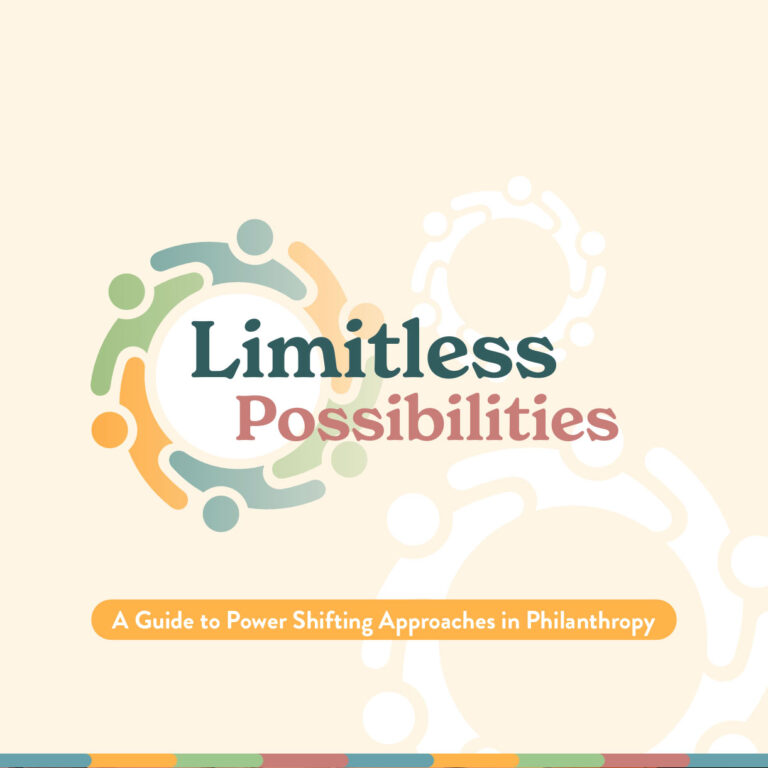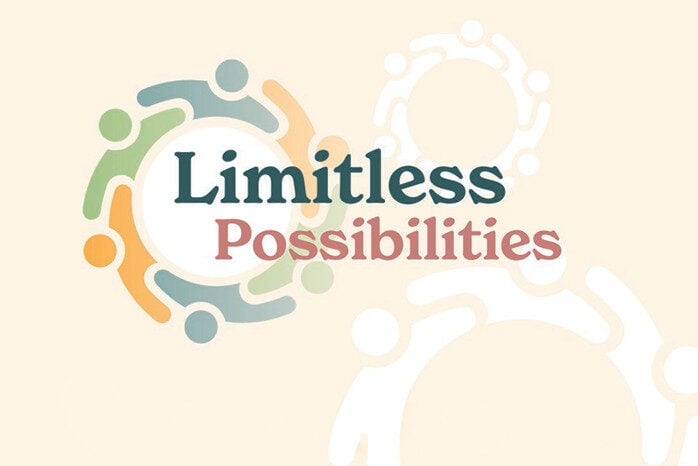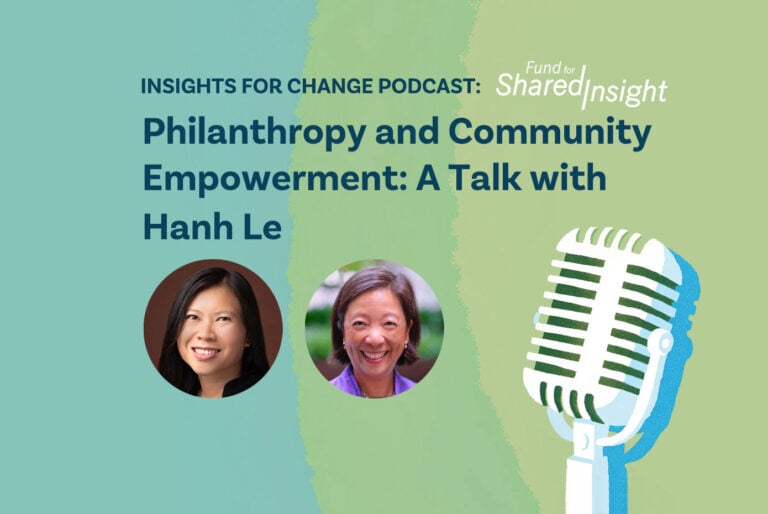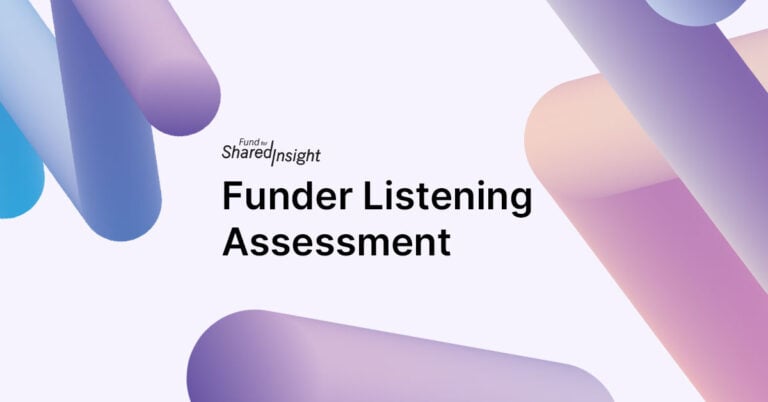Our identities as Black women working to advance racial justice inform our insights as we navigate the world. We draw strength from our ancestors and reflect on our experiences as we strategize ways to maximize our impact with our partners.
As the fight to shift power to communities most impacted by racism and oppression grows more urgent, our work becomes even more important. Fortunately, we recognize that we already possess the wisdom needed to guide us in this changing moment. Some of that wisdom comes from the many, many interviews we did with funders and nonprofit leaders that informed our report, Limitless Possibilities: A Guide to Power Shifting Approaches in Philanthropy.
They confirmed that shifting power calls for a shift in mindset away from viewing power as vested only in institutions that provide resources, to the mindset that funders can create the conditions to exercise power with grant partners and communities. And the report highlights some insights that can help funders delve deeper into what community — and real community engagement and power shifting — mean. Among them:

A report about power shifting approaches in philanthropy with practical guidance intended to impact strategy, grantmaking, and other aspects of foundation work and culture.
- Communities are defined by the community members themselves. Community members share one or more characteristics such as common geographical location, culture, lived experience, or conditions that impact them. When funders recognize that communities have the agency to determine how they are characterized and named over time, they demonstrate their respect for the community.
- Communities have their own power. Communities have power in the form of knowledge, relationships and networks, and other forms of social capital. Funders wishing to share power or shift power to communities recognize that they do so by exercising their power in ways that allow communities to best utilize their own power.
- Engaging communities necessitates a mindset shift. Funders must shift their mindset to trust communities’ ability and agency to identify important issues in their communities and generate sustainable solutions.
- Communities can use their power together with philanthropic funders. Exercising ‘power with’ enables communities, funders, and grant partners to be in true partnership, working in a more generative way, oriented toward mutuality and love for humanity and centered on building responsive relationships with groups and across partners.
Practical guidance for community engagement
Now more than ever, deep listening and meaningful collaboration should be at the core of community engagement efforts, built on mutual trust and respect. Authentic engagement requires funders to be culturally responsive, actively learning about and understanding communities — their needs, culture, history, context, strengths, and priorities. This commitment goes beyond one-time interactions; it is an ongoing responsibility to listen, adapt, and support communities in meaningful ways.
No matter where along the continuum of engagement — from community consultation to community led and owned efforts — cultivating relationships and trust are key to engagement success. Through our work with the report and experience and reflection in the field, we recommend practices for authentic community engagement, including:
Setting up staff to have the tools and resources, including time, to build relationships. Before entering the community, foundations should give the space for employees to learn about cultural responsive practice, power dynamics that influence relationship development, and relational boundaries. Proactive practices to prepare for engagement decreases the burden on community members to “teach” staff how to best engage with community members and gives employees a new vantage point as they move forward on their individual and collective journey.
Examples include training in unconscious bias, deep listening skills, and equity focused strategies to expand networks of potential grant partners that are closest to the communities you seek to serve. Funders may also institute staff positions devoted to engaging with community members as well as being a resource on community engagement best practices for other staff.
Stepping into community spaces. This can be a good option when foundations are just starting to build trust, as it creates an opportunity to engage the community within spaces they feel comfortable and more community members can access. This practice is especially useful in the current moment when many communities, particularly those composed of marginalized groups, are under political threat or face other risks, and may not want to gather in funder spaces or other places outside their community. When funders step into the community, they approach members with humility, honoring their agency and expertise to learn about ever-changing needs while minimizing the burden to the community.
Examples include community meetings, listening tours, and peer spaces. Listening tours are an approach to gather insight by engaging directly with the community through conversations, meetings, or forums. A peer space for community engagement is a collaborative environment where individuals with shared experiences, interests, or identities come together to exchange ideas, provide mutual support, and co-create solutions.
Cultivating authentic relationships through direct communication, healthy conflict, and a willingness to adapt. This process involves creating spaces for open dialogue, including constructive criticism for the funder and genuine thought partnership. It also demands continued flexibility and responsiveness, especially in an ever-changing landscape. When nurtured with care and consistency, these relationships can deepen over time, evolving into strong, lasting partnerships that drive meaningful impact.
Examples can include co-designed site visits and frank discussions about power and any penalties, explicit or implicit, for criticizing or disagreeing with the funder.
‘Listening and solidarity tour’
A small, social justice-focused foundation based in the South shared its approach to cultivating meaningful relationships within the community as a key strategy for shaping their grantmaking practices. One of their core values is learning — approaching their work with curiosity and valuing input from those directly engaged in frontline efforts. To put this into action, they developed a participatory decision-making group, an advisory board, which led to a “listening and solidarity tour.” The goal of this tour was to meet people where they are, understand their work, and learn about the communities they serve.
The foundation engaged with grantees and other stakeholders during this tour to refine goals and strategic pathways. The tour emphasized the importance of relationship-building and power-sharing, with grantees and advisors playing a crucial role in shaping funding priorities. The organization synthesized insights from the tour and shared them with its advisory group and grantee partners, fostering deeper collaboration, and leading the foundation to become more responsive to community needs.
A call to action
Learning about the efforts of that social-justice foundation and hearing from funders across the country for our report, reminds us that we know what we need to do to meet the moment we are in. Listening to center and engage with communities is essential. We call for collective action from philanthropy — action rooted in truth, integrity, and a commitment to uplifting humanity — to ensure the resilience and sustainability of approaches that help communities flourish.
The nonprofit sector is a diverse and vibrant tapestry whose already frayed edges are under threat of devastating rips and tears. The ways funders exercise their power and partner with communities can help mend that tapestry, preserving and advancing equity and bringing about the systems transformation for racial justice we want to see.
About the authors:

Ashley Barnes, MA

Tracy Hilliard, PhD, MPH









